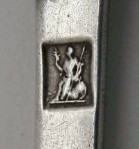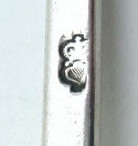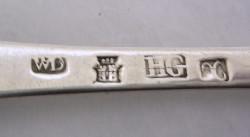Definition
A hallmark is an official stamp on gold, silver and other precious metal articles, impressed by an assay office to attest their standard.
History
English gold and silver articles have been marked by some form of hallmark since the 13th Century. This duty was originally carried out at Goldsmiths hall in London. Today there are four assay offices in the UK, although there have been several others over the intervening years. Please click here for more information on Assay Offices.
Components of a Hallmark
Today a hallmark consists of three compulsory marks ("925" standard mark, assay office mark and sponsors' mark), with two optional voluntary marks (lion passant and date letter). However until 2000 the system had been more or less the same for 450 years.
The four standard marks of a hallmark were the standard/purity mark, the assay office symbol, the date letter and the maker's mark. A fifth duty mark was used between 1784 and 1890.
The Standard Mark
In the case of silver there are two standards, Sterling (92.5%) and Britannia (95.8%). Sterling silver in England is represented within a hallmark by a lion passant and Britannia standard by a seated figure of Britannia holding a spear and shield. A lion rampant or thistle represents the Sterling standard in Scotland and a harp crowned in Ireland.

Lion passant

Britannia

Lion rampant

Crowned Harp
Today, the metal purity is tested, by taking a scrape from each article and subjecting the scrape to an electronic analysis. In the past, several other methods were used. The earliest method was by the touch (rubbing the metal on a touch-stone and comparing those rubbings with a sample of known pure silver), a later alternative was by crucible which involves the melting away of all impurities and comparing the resultant weight of pure silver with the weight of the original sample.
The Date letter
Each assay office had its own cycle of letters, with each cycle using a different style of lettering. It is therefore possible to provide an exact date of manufacture for every piece of English, Scottish and Irish hallmarked silver. London used a 20 year cycle using the letters A to U, Birmingham used a 25 year cycle, others had varying lengths. Sheffield assay office used a very complicated system, with no apparent order in its early years. From 1975 the four assay offices used the same date letter system.
The date letter, up until 1975, changed in May (on St. Dunstan's Day - the patron saint of silversmiths) of each year. Hence, an item described as "made in 1750", theoretically could have been made the following year and should really be described as being 1750/51. From 1975 the date letter was changed every year on January 1st.
The date letter on early spoons (especially trefids) is the most vulnerable to being over-polished due to its position high up the stem towards the terminal. Inability to read the date letter will reduce the value of the spoon.
There are plenty of books available, with tables showing all the date letter cycles for each assay office. Dating silver from hallmarks, can with practice prove very straight forward.
The Assay Office Mark
For more information please see separate section on assay offices.
The Makers' Mark
A Statute of 1363 ordained that every master goldsmith (or silversmith) should have his own mark. This mark would betray any spoon maker producing articles made from sub-standard metal. Initially, due to poor levels of literacy, each smith was identified by a symbol, e.g. flower petals, bellows and crowns.
The initials of the silversmith began to replace symbols in the 17th century, although the practice of including a symbol amongst the letters continued well into the next century. The statute of 1697 which raised the standard of plate silver to Britannia quality also changed makers' marks to the first two letters of his surname. The restoration of Sterling standard in 1719 re-introduced the silversmiths initials as a form of marking.
The maker’s mark was formerly struck by the maker, prior to sending to assay, which is why this mark often appear upside down or set apart from the other marks. Nowadays, the assay office usually strikes this mark as well.
It will be noted that the mark most often in good condition on bottom-struck spoons is the maker's mark. Over-polishing can rub the hallmarks, but because the standard position, on bottom-struck spoons, of the makers mark is nearest the bowl, it is protected during the sweep of a polishing stroke by the bowl. The opposite is true for top-marked spoons. The maker's mark is most often rubbed. There are a number of reasons for this; worn out punches, the mark was not stamped deeply enough, or its position (usually nearest the terminal) making it the most vulnerable to over-polishing.
Lengthy research in recent years has given us the opportunity of putting names to these symbols and initials. Several books are available from us on the subject.
For more information please see separate section on spoon-makers.
The Duty Mark
The burden of the American War of Independence on the UK governments' purse, lead Goldsmiths Hall to add a fifth hallmark in 1784 to confirm that a tax had been paid on each piece of silver made. This was called the duty mark and a representation of the monarch's head was chosen as its symbol. The duty marked was discontinued in 1890 when the tax on silver was abolished.
The duty marks used during the reigns of King George III, George IV and William IV show a profile of the monarchs head facing right and that of Queen Victoria facing left.

London 1802 (inc. Geo III duty mark)

London 1832 (inc. Wm. III duty mark)

London 1844 (inc. Victoria duty mark)
The duty mark was originally struck incuse as opposed to the other marks which are struck intaglio (in cameo form). The incuse mark is quite a rarity as it was only used between 1st December 1784 and 29th May, 1786 and good examples of this mark are sought after - see far left mark in the illustration below from a table spoon of 1785. Examples of the more common (intaglio) duty mark are shown above.
An ultra rare mark is the duty drawback mark which is symbolised by a standing figure of Britannia holding a spear and shield (the uppermost mark in the image below on the marks for a Hester Bateman cream ladle). This mark was first used at the same time as the duty mark to represent the repayment of duty for exempt items that were being exported. It was discontinued on 24th July 1785 because of the damage caused to finished goods by its stamping, although drawback itself continued.
Variations of the duty mark can be found when levies were increased. In 1797, the duty to be paid was doubled and is represented on London silver by a clipped punch shape, other assay offices struck the duty mark twice (see illustration below) - this is known as a double duty mark. The tax on silver was further increased in 1804 and 1815.

Incuse Duty Mark, London 1785

Duty Drawback Mark

Double Duty Mark, Birmingham 1797
Commemorative Marks
During the 20th and 21st centuries an optional fifth mark has been stamped by the assay offices to represent times of national celebration. These are as follows:-
- 1934/5 Silver Jubilee of King George V and Queen Mary
- 1953/4 Coronation of Queen Elizabeth II
- 1977 Silver Jubilee of Queen Elizabeth II
- 1999/2000 Millennium
- 2002 Golden Jubilee of Queen Elizabeth II
- 2011/12 Diamond Jubilee of Queen Elizabeth II
- 2021/22 Platinum Jubilee of Queen Elizabeth II
The Assay Master's Mark
Edinburgh marked silver, prior to 1760, appears to be stamped with two maker's marks. One of these marks is that of the Assay Master (or Deacon prior to 1681) whose stamp was punched to show that the standard was correct. This mark was replaced by the thistle in 1760.
 The marks illustrated are for Edinburgh 1752 by William Davie with the additional mark of Hugh Gordon assay master.
The marks illustrated are for Edinburgh 1752 by William Davie with the additional mark of Hugh Gordon assay master.
We offer a large selection of antique silver that illustrates all of the above hallmarking features. Rare and unusual hallmarks are featured on this page: Curiosities and Novelties
whilst the full contents of our online shop can be found by clicking this link: SHOP
